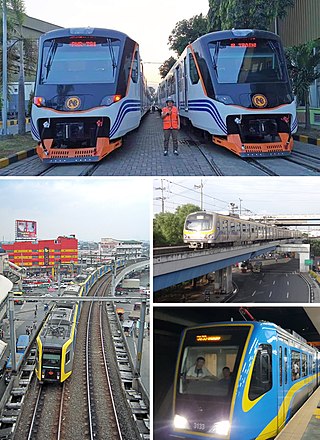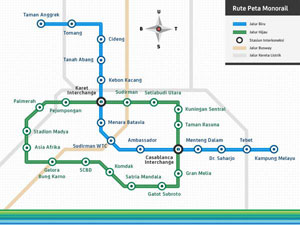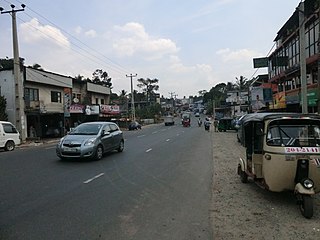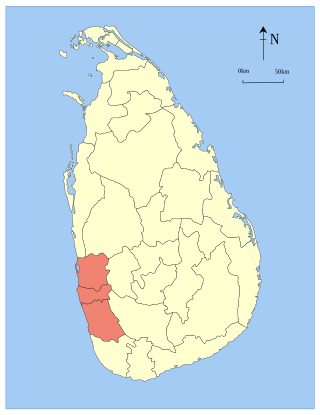Related Research Articles

A monorail is a railway in which the track consists of a single rail or beam. Colloquially, the term "monorail" is often used to describe any form of elevated rail or people mover. More accurately, the term refers to the style of track. Monorail systems are most frequently implemented in large cities, airports, and theme parks.

Rail transportation in the Philippines is currently used mostly to transport passengers within Metro Manila and provinces of Laguna and Quezon, as well as a commuter service in the Bicol Region. Freight transport services once operated in the country, but these services were halted. However, there are plans to restore old freight services and build new lines. From a peak of 1,100 kilometers (680 mi), the country currently has a railway footprint of 533.14 kilometers (331.28 mi), of which only 129.85 kilometers (80.69 mi) are operational as of 2024, including all the urban rail lines. World War II, natural calamities, underspending, and neglect have all contributed to the decline of the Philippine railway network. In the 2019 Global Competitiveness Report, the Philippines has the lowest efficiency score among other Asian countries in terms of efficiency of train services, receiving a score of 2.4, and ranking 86th out of 101 countries globally. The government is currently expanding the railway network up to 1,900 kilometers (1,200 mi) by 2022 through numerous projects.

Rapid KL is a public transportation system owned by Prasarana Malaysia and operated by its subsidiaries Rapid Rail and Rapid Bus. The acronym stands for Rangkaian Pengangkutan Integrasi Deras Kuala Lumpur, which translates to Kuala Lumpur Rapid Integrated Transport Network in the Malay language. Rapid KL, with its 204.1 km (126.8 mi) of metro railway and 5.6 km (3.5 mi) of BRT carriageway, is part of the Klang Valley Integrated Transit System, operating throughout Kuala Lumpur and Selangor's satellite cities in the Klang Valley area.

The Jakarta Monorail was a cancelled monorail network project in Jakarta, Indonesia. If completed, it would have comprised two lines, totalling up to 29 km (18 mi).
Rapid Rail Sdn Bhd is the operator of the rapid transit (metro) system serving Kuala Lumpur and the Klang Valley area in Malaysia. A subsidiary of Prasarana Malaysia, it is the sole operator of five rapid transit lines which collectively form the Rapid KL rapid transit system. The system currently consists of three light rapid transit (LRT) lines, two mass rapid transit (MRT) lines and a monorail line, with another MRT and LRT line currently under construction.

The Sri Lanka Railway Department is Sri Lanka's railway owner and primary operator. As part of the Sri Lankan government, it is overseen by the Ministry of Transport. Founded in 1858 as the Ceylon Government Railway, it operates the nation's railways and links Colombo with other population centres and tourist destinations.
Malabe is a suburb of Kaduwela in the Colombo District, Sri Lanka. It is situated on the New Kandy Road about 10 km (6.2 mi) away from the centre of the commercial capital Colombo. This suburb is a crucial economic centre in Colombo.

The MRT Yellow Line or MRT Nakkhara Phiphat Line is an elevated monorail line in Bangkok and Samut Prakan Province, Thailand, part of the MRT rapid transit system. The 28.62 km (17.78 mi) line has 23 stations and cost 55 billion baht. The line was originally proposed in 2005 by the Office of Transport and Traffic Policy and Planning to be a heavy rail underground line along Lat Phrao road which was then elevated from Lam Sali Intersection to Samrong. However, it was decided in 2012 to build an elevated monorail line for the whole length in order to reduce construction costs.

Kottawa is one of the main suburbs in Colombo, Sri Lanka and is administered by the Maharagama Urban Council. It is located 21 km (13 mi) from the centre of Colombo. It is a five-way junction and lies as the epicenter for Maharagama road, Homagama road, Piliyandala road, Malabe road and Borella road.
Thiruvananthapuram Metro is a proposed rapid transit system in the city of Thiruvananthapuram, the capital of the Indian state of Kerala. Thiruvananthapuram, the capital city of Kerala, is all set to have its metro system. Earlier, there was a plan to build a light metro system in the city. However, the plan was later changed to a conventional metro system.

Kozhikode Light Metro is a proposed Light Metro system for the city of Kozhikode, in India. In 2010, the State government explored the possibility of implementing a metro rail project for Kozhikode city and its suburbs. The proposal was to have a corridor connecting Meenchanda to the Kozhikode Medical College Hospital through the heart of the city. An inception report was submitted by a Bangalore-based consultant, Wilber Smith, on the detailed feasibility study on the prospect of implementing the Mass Rapid Transport System (MRTS) and Light Rail Transit System (LRTS) in the city. However, the project has been scrapped to be replaced by Kozhikode Monorail project.

Lotus Tower, also referred to as Colombo Lotus Tower, is a 351.5 m (1,153 ft) tall tower, located in Colombo, Sri Lanka. It has been called a symbolic landmark of Sri Lanka. As of 2019, the tower is the tallest self-supported structure in South Asia; the second tallest structure in South Asia after the guy-wire-supported INS Kattabomman in India; the 11th tallest tower in Asia and the 19th tallest tower in the world. It was first proposed to be built in the suburb of Peliyagoda but later the Government of Sri Lanka decided to change the location. The lotus-shaped tower is used for communication, observation and other leisure facilities. Construction is estimated to have cost US$113 million.
The Metro Rail Transit Line 4 (MRT-4) is a proposed rapid transit line that would serve the Greater Manila Area of the Philippines. The 12.7 km (7.9 mi), 10-station elevated railway would connect Ortigas Center in Metro Manila and the suburban municipality of Taytay, Rizal. It would traverse along Ortigas Avenue and Manila East Road, starting at the former's junction with EDSA in Quezon City to the west until it terminates near the New Taytay Public Market to the east.

The Jabodebek LRT, formerly known as Greater Jakarta LRT is a light rapid transit system in Greater Jakarta, the capital city of Indonesia, as well as the adjacent areas of West Java, within the Jakarta Metropolitan area. It was implemented by the central government, and operated by Kereta Api Indonesia (KAI), the system connects the Jakarta city center with suburbs in Greater Jakarta such as Bogor, Depok and Bekasi, hence its acronym Jabodebek.

The South Sumatra Light Rapid Transit, colloquially known as LRT Palembang or Palembang LRT, is an operational light rapid transit system in Palembang, South Sumatra, Indonesia which connects Sultan Mahmud Badaruddin II International Airport and Jakabaring Sport City. It is the first practical modern light rapid system to operate in Indonesia. It was also the first rail line as a rapid transit system in the country.
The BMA Bang Na–Suvarnabhumi line is a proposed light rail line in Bangkok that would run from Bang Na junction to Suvarnabhumi Airport. The line was first proposed in 1994, but it was not included in the 2005 OTP Mass Rapid Transit Master Plan. Initially, it was planned for the line to potentially be a BTS Sukhumvit Line branch line with turnouts constructed near Bang Na junction. In December 2015, the BMA said it would advance construction and would propose it to cabinet in the near future. In April 2016, deputy governor Amorn Kitchawengkul said the project would take 3–6 years and cost THB 20 billion.

The Western Region Megapolis is an urban planning, zoning, and development area stretching from Negombo in the north to Beruwala in the south. It is designed to create a megapolis in Sri Lanka's Western Province by 2030.
The Western Region Megapolis Light Rail Transit System is a proposed metropolitan light rail system which will serve the designated Western Region Megapolis area within the Colombo District, Sri Lanka. The system is planned to be operated as a public-private partnership between the Government of Sri Lanka and selected private entities.
The Cebu Monorail Transit System, simply known as the Cebu Monorail, is a proposed monorail rapid transit system to be built in Metro Cebu, Philippines. Originally proposed by the Japanese in 2015 as the Cebu MRT System, it was revised to a light rail line in the late 2010s, dubbed the Cebu Light Rail Transit System or Cebu LRT. It was then again revised to its present form in late 2019.
The Salvador LRT, also known as Salvador and Metropolitan Region LRT or Suburban LRT, is a Brazilian urban rail transit system public transport, based on light rail transport (LRT) system, currently under construction in Salvador and Simões Filho, municipalities in the Metropolitan Region of Salvador, Bahia.
References
- ↑ "Sri Lanka to build US$1.3bn monorail with Japan finance". Daily mirror. 2014-11-01. Archived from the original on 2014-12-10. Retrieved 2014-12-08.
- ↑ "Public investment in bus, railway a priority before monorail, says transport experts". Lanka Business Online. Retrieved 2015-12-08.
- ↑ "Sri Lanka's monorail plan shelved; light rail on the cards was | The Sunday Times Sri Lanka". www.sundaytimes.lk. Retrieved 2016-07-07.
- ↑ "What's In Store For The Colombo Transport Plan?".
- 1 2 "Why Light Rail Transit (LRT) was selected over Monorail" (PDF). Archived from the original (PDF) on 2016-10-11.